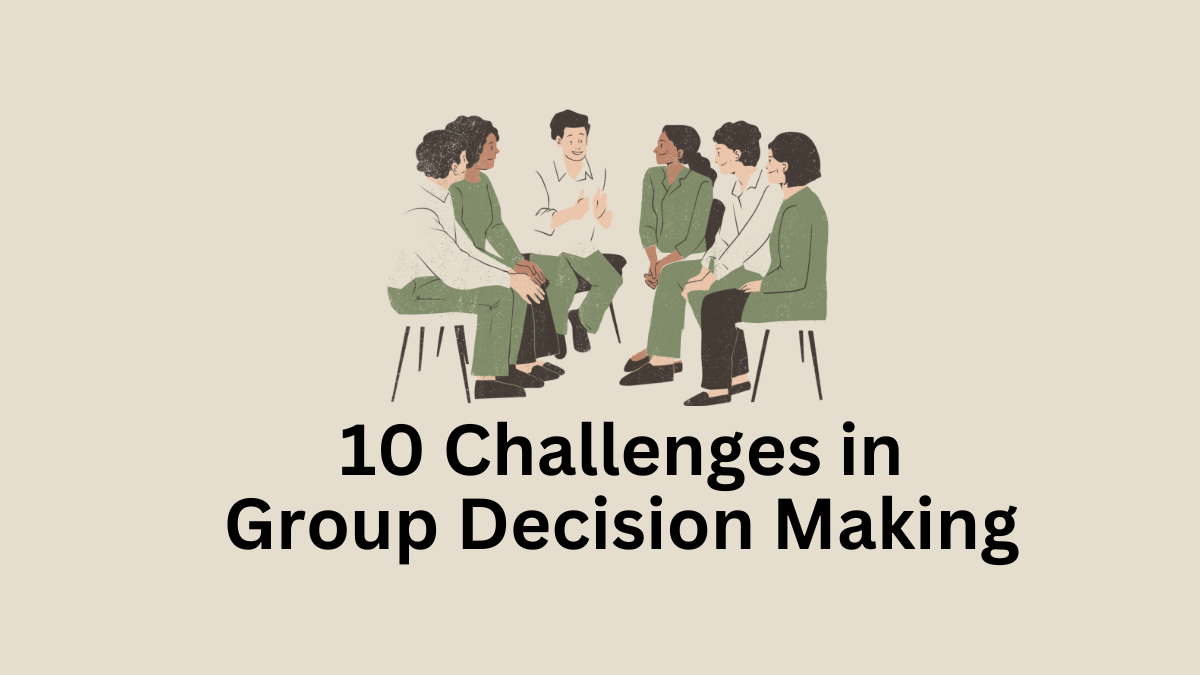Challenges in Group Decision Making
Group decision-making is a dynamic process that can lead to innovative solutions and increased team cohesion. However, it also presents several challenges that can hinder effective decision-making.
Below are the 10 challenges in group decision making and strategies to overcome them.
Dominance of Strong Personalities
Challenge: In group settings, individuals with assertive personalities may dominate discussions, stifling the input of quieter members and limiting the diversity of opinions.
Strategy: Encourage equal participation by setting ground rules for discussion, facilitating turn-taking, and explicitly inviting input from all members. Additionally, provides opportunities for quieter members to contribute their ideas outside of group meetings, such as through written submissions or one-on-one discussions.
Groupthink
Challenge: Groupthink occurs when members prioritize consensus over critical evaluation, leading to flawed decisions and the suppression of dissenting opinions.
Strategy: Foster an environment that encourages constructive debate and dissent by valuing diverse perspectives and rewarding critical thinking. Assign a devil’s advocate role to challenge prevailing assumptions and encourage members to voice their concerns openly. Encourage independent thinking by allowing members to submit individual proposals before group discussions.
Social Loafing
Challenge: Social loafing refers to the tendency of some members to contribute less effort in group settings, relying on others to carry the workload.
Strategy: Promote accountability by assigning specific roles and responsibilities to each member and regularly monitoring progress towards goals. Encourage a culture of recognition and appreciation for individual contributions to motivate members to actively participate. Set clear expectations for performance and provide feedback on individual contributions to ensure accountability.
Lack of Clear Accountability
Challenge: In group decision-making, accountability may be diffused, making it challenging to attribute responsibility for outcomes.
Strategy: Clarify roles and responsibilities at the outset of the decision-making process, assigning specific tasks to individual members and establishing clear criteria for success. Implement mechanisms for tracking and documenting individual contributions, such as progress reports or task lists. Hold regular debriefings to review decision outcomes and identify lessons learned for future improvement.
Time Constraints
Challenge: Group decision-making can be time-consuming, especially when coordinating schedules and facilitating discussions with multiple participants.
Strategy: Prioritize decision-making tasks based on urgency and allocate sufficient time for thorough discussion and analysis. Use technology tools such as online collaboration platforms or video conferencing to facilitate virtual meetings and streamline communication. Break larger decisions into smaller, manageable tasks to distribute workload and maximize efficiency.
Read More: 10 Challenges in Organizational Goals Setting
Resistance to Change
Challenge: Members may resist change, particularly if they feel threatened or uncertain about the implications of proposed decisions.
Strategy: Address concerns and objections openly, providing rationale and evidence to support the need for change. Involve members in the decision-making process from the outset, soliciting their input and actively listening to their perspectives. Communicate transparently about the potential benefits of proposed changes and provide opportunities for feedback and dialogue to address concerns.
Group Polarization
Challenge: Group polarization occurs when members’ initial inclinations towards a particular decision become more extreme after group discussion, leading to riskier or more conservative choices.
Strategy: Encourage members to consider a diverse range of viewpoints by presenting alternative perspectives and challenging assumptions. Facilitate balanced discussions that explore the potential risks and benefits of different options, encouraging critical thinking and careful evaluation. Implement decision-making techniques such as devil’s advocacy or scenario planning to counteract the effects of group polarization.
Read More: 10 Challenges in Planning in Management
Lack of Information Sharing
Challenge: Members may withhold or selectively share information, leading to incomplete or biased decision-making.
Strategy: Foster a culture of transparency and open communication by encouraging information sharing and discouraging siloed behavior. Establish clear guidelines for data sharing and accessibility, ensuring that all relevant information is made available to decision-makers. Promote collaboration and knowledge sharing through cross-functional teams and regular updates on project progress and findings.
Conflict Resolution
Challenge: Conflicts may arise during group decision-making, stemming from differences in opinions, values, or interests among members.
Read More: 10 Challenges in Decision Making
Strategy: Develop conflict resolution strategies and techniques to address disagreements constructively and prevent escalation. Encourage active listening and empathy to understand the perspectives of others and find common ground. Facilitate open dialogue and negotiation to reach a consensus on contentious issues, leveraging third-party mediators or facilitators if necessary.
Lack of Decision Clarity
Challenge: Group decisions may lack clarity or consensus, leading to confusion or ambiguity about the chosen course of action.
Strategy: Define decision criteria and objectives clearly at the outset of the decision-making process, ensuring that all members understand the desired outcomes and parameters for evaluation. Use decision-making tools such as decision matrices or scoring models to facilitate systematic evaluation and comparison of alternatives. Document decisions and rationale comprehensively to ensure accountability and facilitate implementation.
In conclusion, hence these are the 10 challenges in group decision making and strategies to overcome them.
Read Next: 10 Challenges in Job Design
